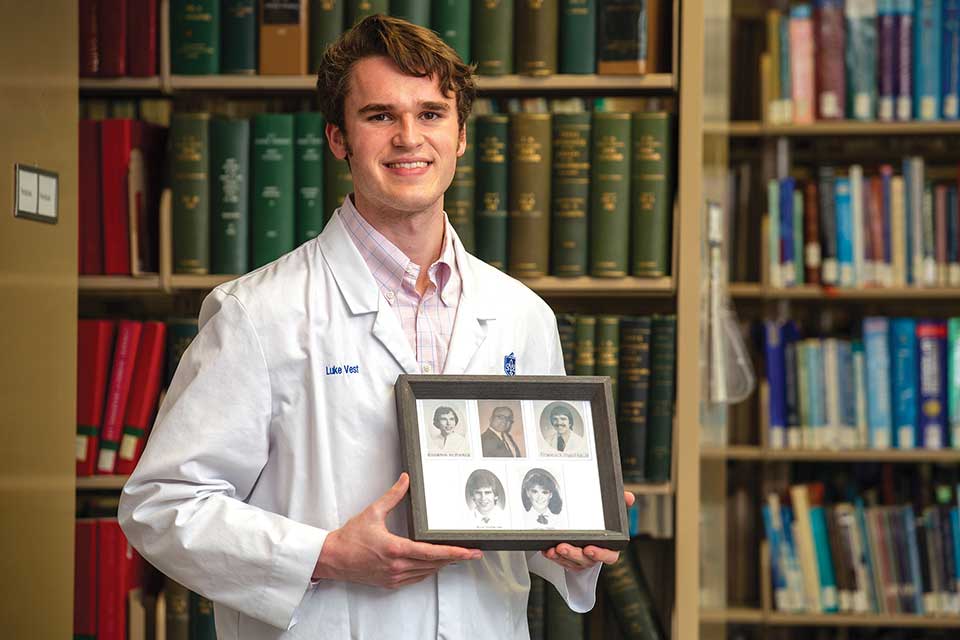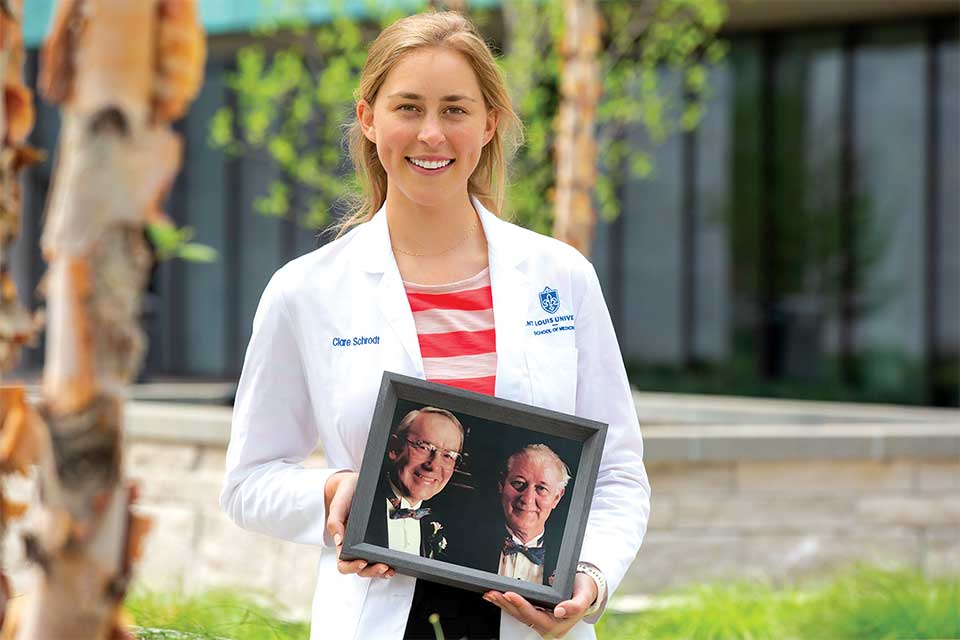All In the Family—From a Medical Home to the School of Medicine
The formative years of medical school offer students a unique opportunity to hone their skills, create long-lasting relationships with colleagues, and fortify their passion for medicine. For fourth-year medical students, Luke Vest and Clare Schrodt, the transition from their medical families to the Saint Louis University School of Medicine has offered them all of that—and more.
Luke Vest
For Luke Vest, attending the SLU School of Medicine meant building on the powerful and instrumental legacy of his family—one filled with an astounding number of doctors who also attended SLU. “One of the first people to be involved at SLU was my paternal grandmother, Dr. Eugenia Pierce Vest,” Vest shares. “She graduated in 1958 and was one of three women in her class.”
On the other branch of the Vest family tree is his maternal grandfather, Dr. Francis X. Paletta Sr., who founded the SLU Plastic Surgery Residency Program in 1957. His eldest son, Francis X. Paletta Jr., trained in plastic surgery at SLU and graduated in 1983. In 1997, his other son Dr. Christian Paletta became the Division Chief of Plastic Surgery at SLU and led the program for over a decade.
Both of Vest’s parents, Bruce Vest, M.D., and Kathleen Vest, M.D., graduated from SLU School of Medicine in 1985, and Vest recalls his family frequently discussing science and medicine at home. These conversations gave Vest and his seven siblings—five of whom are doctors—a unique insight into the world of becoming a clinician.
“My dad would come home with his X-rays and show us all the broken bones,” Vest recalls. “And I always thought it was great. It was just normal to us, so I was never really queasy with any of that stuff.”
Despite this intimate knowledge of the profession, Vest initially wanted to pursue a career in engineering. “I was always interested in technology,” he says. “But it wasn’t until I had an experience with a neurologist for headaches when I realized the impact a physician can have on others.”
At that time, Vest recounts, he decided to give medicine another look—and when his dad took him to the American Academy of Orthopedic Surgeons conference, Vest saw an exhibit with robot-assisted surgery. “I thought, ‘Wow, you can use technology and medicine, and the doctors are helping develop it,” he says. “I realized that medicine and technology were completely intertwined and I could combine both of those interests.”
This moment served as the catalyst for Vest to follow in the footsteps of his family and join the SLU School of Medicine.
As Vest has transitioned to medical school, he’s experienced many of the new curriculum changes at SLU—and he notes that these shifts have had a positive impact on his preclinical work and allowed him to connect with colleagues in his cohort. “It’s really great to get put together with students you wouldn’t have otherwise had a chance to meet,” he says.
As he enters his fourth year of medical school, Vest reflects on his time in the clinical setting and looks forward to more clinical time with patients. “Seeing patients affected by the pathologies we study helps humanize it,” he shares, “I’m really excited.”
Clare Schrodt
Clare Schrodt, a native of Louisville, Kentucky, also hails from an impressive lineage of doctors: a radiologist, an internal medicine physician, a pathologist, and a psychiatrist. But for Schrodt, becoming a doctor was a “long, winding path,” and one she never expected.
Only in the midst of completing her undergraduate degree at SLU in neuroscience did Schrodt realize just how interested she was in medicine—and how much she loved being a student at SLU. “I wanted to stay here because I knew medicine would be a huge part of my life,” Schrodt says. “But the biggest part of medicine is making sure people are treated with respect—and SLU teaches that.”
Now in her eighth year at SLU, Schrodt reflects on completing her third year of medical school, which brought her newest challenge: Treating patients in the clinical setting.
While the first two years of medical school are preclinical, year three places students into clinical rotations—an experience that is both overwhelming and invigorating. “When I look back, I see all the small nuances of patient care that you can’t learn in a book,” she says. “There’s a complexity to each person that you just can’t replicate.”
As students in their third year are overseen by residents and attending physicians on their team, they continue to learn what it means to be a physician—and this process helps students determine a specialty for their future career. To aid in that process, students rotate through seven different clerkships, participate in weekly lectures, and work at the hospital with patients.
“As we’re rotating through each clerkship, you see some students light up and find their groove,” says Schrodt. “Your third year is when you watch your friends and your colleagues find their passion. We’re not only engaging with patient care, but we’re deciding what we’re going to do as a career.”
For Schrodt, her “light-up” moment came during one of her first rotations in neurology. “What drew me most to neurology was a mix of circumstances and interactions with patients in their most dire moments,” she recalls. “You have the potential to step in and make sure that they feel confident and taken care of. It’s one of those really vulnerable situations that I feel like, as a doctor, you can make such a difference in someone’s life.”
As Schrodt follows her passion for neurology, she’s learning how to support and connect with her patients: “The biggest takeaway is seeing not just mechanically how to treat patients—but how to spiritually and emotionally interact with patient populations and families and kids. It’s an irreplaceable experience.”

